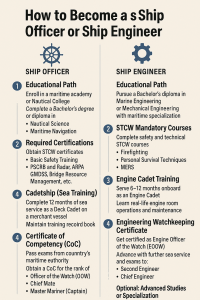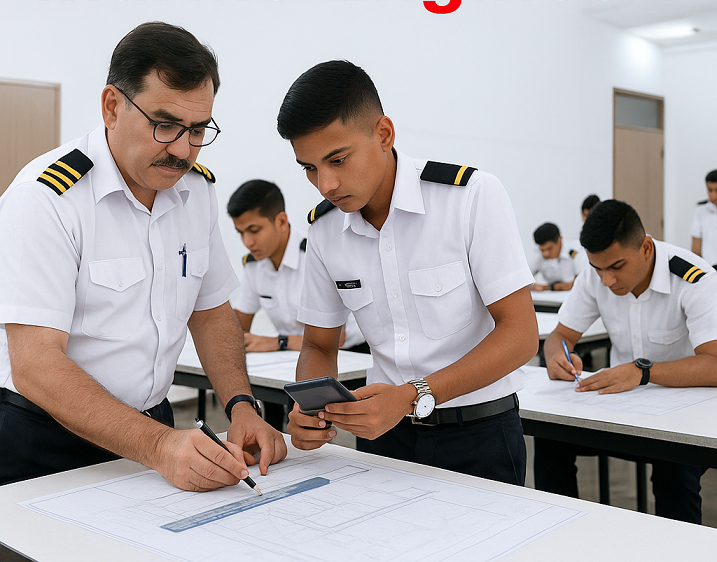Are you passionate about the sea and looking to build a career that combines technology, adventure, and global travel? Becoming a ship officer or marine engineer might be the perfect career path for you. This guide breaks down everything you need to know—from education to certification and career progression—so you can confidently chart your course in the maritime industry.
What Is a Ship Officer or Ship Engineer?
-
A ship navigation officer (also known as a deck officer or navigation officer) is responsible for the navigation, safety, and management of a vessel.
-
A ship engineer (also known as a marine engineer) handles the machinery, propulsion systems, and technical operations onboard.
Both roles are essential and require specialized training, certifications, and seafaring experience.
Step 1: Complete Secondary Education
Before you can join a maritime training program, you must have a high school diploma or equivalent, with a strong background in:
- Mathematics
- Physics
- English
- Technical drawing or mechanics (if available)
Some academies may also require entrance exams or interviews.
Step 2: Enroll in a Maritime Academy or Training Institute
Choose an accredited maritime training institute or nautical college/university that offers programs in:
- Nautical Science (for deck officers)
- Marine Engineering or Naval Architecture (for ship engineers)
Look for STCW-compliant institutions that offer:
- Theoretical classes
- Practical lab sessions
- Simulator-based training
- Cadetship placement opportunities
Popular Courses Include:
- BSc in Nautical Science
- BSc in Marine Engineering
- Diploma in Marine Technology
- Electro-Technical Officer (ETO) Course
Step 3: Obtain Mandatory STCW Certifications
The STCW Convention (Standards of Training, Certification, and Watchkeeping) outlines minimum training for seafarers.
Essential courses include:
- Basic Safety Training (BST)
- Personal Survival Techniques
- Fire Prevention and Firefighting
- Elementary First Aid
- Personal Safety and Social Responsibilities (PSSR)
For engineers, Engine Room Simulator training is also required.
Step 4: Gain Sea Time Experience as a Cadet
To become licensed, you need to complete sea service (cadetship) on a vessel under supervision.
Typical duration:
- Deck cadet: ~12 months
- Engine cadet: ~6 to 12 months
During this period, you’ll:
- Practice real-time watchkeeping
- Operate navigation or engineering systems
- Learn safety and emergency protocols
Step 5: Appear for Licensing Exams
After sea time, you must pass your country’s Certificate of Competency (CoC) exams to become a licensed officer.
Issued by the maritime authority (e.g., USCG, MCA, DG Shipping), these exams test:
- Technical knowledge
- Operational procedures
- Safety and emergency handling
- Maritime laws and conventions
Licenses include:
- Second Officer or Third Engineer
- After more experience: Chief Officer, Chief Engineer, or Captain
Step 6: Advance Your Career
Continue gaining sea time, upgrading certifications, and taking advanced courses such as:
- Advanced Firefighting
- Tanker Familiarization
- Ship Security Officer (SSO)
- Bridge Resource Management (BRM)
- Marine High Voltage Engineering
You can also specialize in:
- Offshore vessels
- LNG carriers
- Cruise ships
- Naval or defense vessels

Frequently Asked Questions
Q1: How long does it take to become a ship officer or engineer?
It typically takes 3–4 years from the start of your education to becoming a licensed junior officer, depending on your course and country.
Q2: Is the job physically demanding?
Yes, it can be. Seafarers often face long shifts, rough weather, and technical challenges—but it’s rewarding for those who are passionate.
Q3: Can I switch from deck to engine or vice versa?
It’s possible, but you’ll need to undergo additional training and certification in the new discipline.
Ready to Start Your Maritime Career?
At MaritimeEducation.com, we help aspiring seafarers access:
-
Online maritime courses
-
STCW training info
-
Study guides and mock exams
-
Career tips and job listings
Explore our latest courses or read more guides to take the next step in your career at sea.


